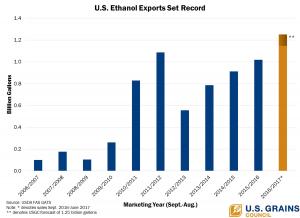Exports of U.S. feed grains in all forms (GIAF) are up 20 percent year-over-year from September-June to 96.9 million metric tons, according to data from the U.S. Department of Agriculture (USDA) and analysis by the U.S. Grains Council (USGC).
With only two months left in the 2016/2017 marketing year, exports by this measure that is inclusive of feed grains and the products they produce could set a new record high, a result of attractive U.S. prices and diligent work by the Council to maintain long-time trading partners and find new areas of near-term demand.
U.S. ethanol exports have already reached a new all-time high at 1.15 billion gallons this marketing year, according to data collected by the U.S. Census Bureau, surpassing the 1.09 billion gallons exported in 2011/2012. Ethanol exports to Brazil more than quadrupled to 438 million gallons, even though purchases are expected to slow in coming months.
Exports of U.S. ethanol to Canada, a key partner through the North American Free Trade Agreement (NAFTA), also increased to 263 million gallons, a five percent growth compared to the same time the year prior. And India set a new record for U.S. ethanol purchases, more than doubling year-over-year to 116 million gallons.
Exports of U.S. corn increased 36 percent year-over-year to 49.9 million tons (1.96 billion bushels), already exceeding export totals for the last five marketing years.
U.S. corn exports to Japan, the traditional top customer of U.S. corn, are up 48 percent compared to the same time the year prior to 11.5 million tons (453 million bushels), surpassing last year’s total with two months of sales remaining. U.S. corn sales to several countries have already outpaced historical sales, including a new record set for exports to Saudi Arabia, the highest exports to Taiwan since the 1994/1995 marketing year and the most corn exported to South Korea in the last 10 marketing years.
The Council is also seeing increased demand for U.S. DDGS as a result of price and efforts to promote the product in a diverse set of markets.
Sales of U.S. DDGS dropped significantly from the two largest traditional markets – China and Vietnam. While this void had a substantial impact, it left ample supply for other world buyers to purchase – and USGC programs throughout the world are helping end-users learn how to incorporate U.S. DDGS into their rations. As a result, overall purchases are only just behind last year’s export pace at 9.32 million tons. In contrast, exports to Mexico, this year’s top market, are up nine percent year-over-year to 1.69 million tons.
Turkey now ranks as the second largest market for U.S. DDGS with exports that nearly doubled year-over-year to 1.11 million tons, the largest amount since the country started purchasing DDGS in 2004/2005. U.S. DDGS exports to South Korea and the European Union also set new sales records at 847,000 tons and 792,000 tons, respectively.
In contrast, U.S. barley exports are down significantly, driven by a drop in sales to the top traditional customer, Mexico. But, exports to Canada and Japan jumped substantially, both already exceeding their total purchases last marketing year, to 62,700 tons (2.88 million bushels) and 22,900 tons (1.05 million bushels), respectively. In Japan, the Council’s market promotion efforts are building demand for barley food-based products, directly benefitting U.S. producers through this increase in sales. Please note the marketing year for barley differs from that of corn and runs June-May.
Export sales of U.S. sorghum also decreased significantly thus far in the marketing year. However, China kept its status as the largest customer with 3.94 million tons in purchases from September-June. Yet U.S. sorghum exports to Japan more than doubled to 182,000 tons, the highest amount in the last five years, while Mexico increased purchases of U.S. sorghum six percent year-over-year to 524,000 tons.
As the 2016/2017 marketing year comes to an end, the Council and members are celebrating a strong export year, while at the same time preparing for a challenging 2017/2018 marketing campaign.
Engagement with both long-standing trading partners and opportunistic buyers combined with attractive prices have allowed U.S. feed grains and co-products to move into markets old and new. As the current marketing year ends and the new one begins, this work on market access, technical education and trade servicing will become increasingly important to secure U.S. market share and continue the Council’s mission of enabling trade, developing markets and improving lives.


